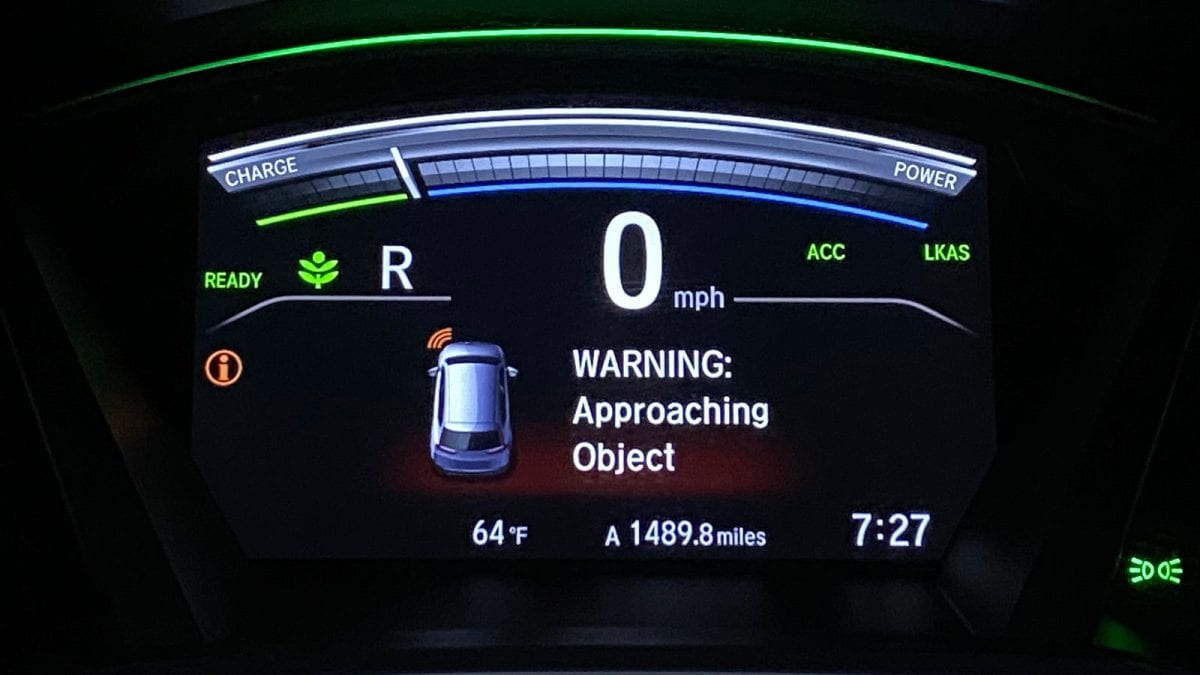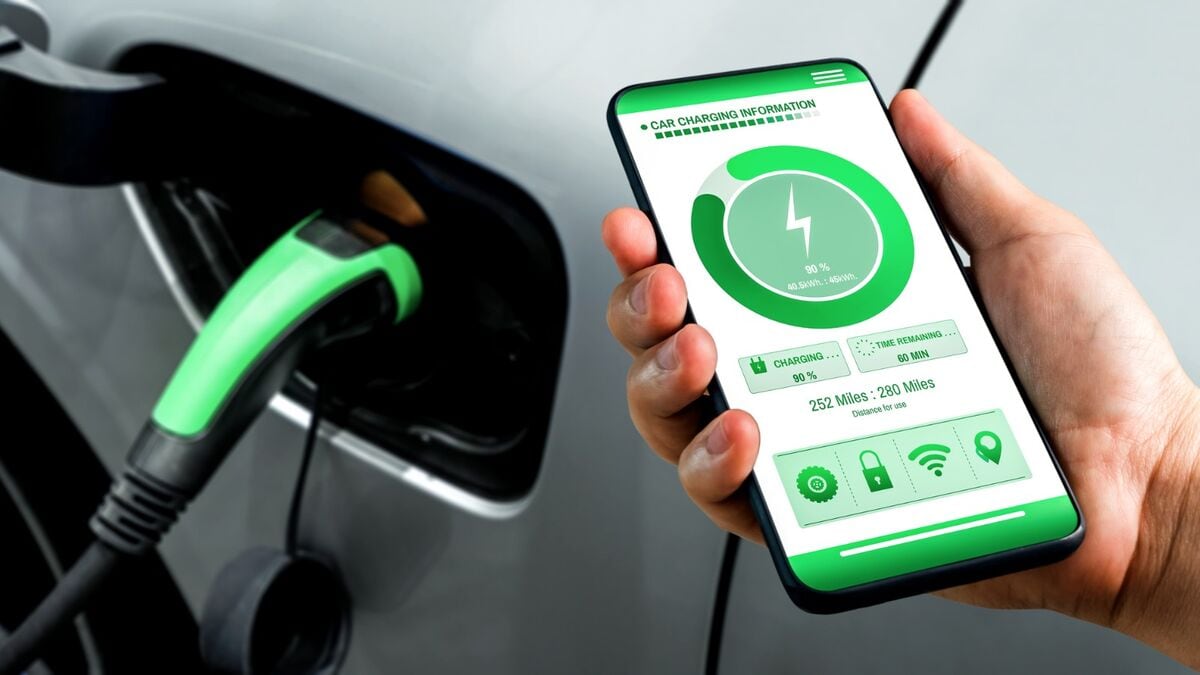Quick Facts About Car Safety Features
- Research shows advanced car safety features may reduce the risk of a serious crash by 49% and lower injury risk by 53%.
- Car safety features can be passive (seat belts and airbags) or active (stability control and automatic emergency braking).
- Most advanced car safety technologies, like blind-spot monitoring and lane-keeping assist, were developed on the path to creating self-driving cars.
- Several of today’s optional advanced car safety technologies will eventually be federally mandated.
Our car safety features guide is an auto safety history lesson and a near-comprehensive list of modern automotive safety tech for those looking to buy a new or used car. For decades, automakers fiercely resisted prominently marketing safety features to the public. For example, seat belts came into being in the 1930s but didn’t move to the forefront until the early 1960s. Carmakers refused to include them for years, fearing the negative safety message that installing seat belts would send.
Today, car companies are just as likely to advertise their safety features as they do fuel economy, technology, or performance. How times have changed. Use our jump links below to skip ahead in the story.
- What Are Car Safety Features?
- Car Safety Features
- Legally Required: Standard Car Safety Features
- Collision Prevention Safety Features
- Speed Control Safety Features
- Vision and Headlight Safety Features
- Other Advanced Car Safety Features
What Are Car Safety Features?
A car safety feature is any feature that helps minimize the chances of an accident or reduces the effects of a collision on the occupants of the vehicle. It encompasses everything from crumple zones to antilock brakes to adaptive cruise control with full braking. A recent report from the National Highway Traffic Safety Administration (NHTSA) and a coalition of carmakers concludes that advanced safety features, such as forward collision alert and automatic emergency braking, reduce the risk of a serious crash by 49% while lowering the risk of injury by 53%.
Car Safety Features
The number of car safety features and driver-aid technologies available in today’s vehicles is astounding and growing by leaps and bounds. We can thank the race to develop fully autonomous cars for many of the advancements.
RELATED: Self-Driving Cars: Everything You Need to Know
- By 1989, Chrysler offered airbags in every passenger car. We’ve come a long way since then. Chrysler’s then-chairman Lee Iacocca used television to begin selling America on the benefits of airbags, but at that point almost no one wanted them or knew we needed them.
- Today, airbags, along with seat belts, antilock brakes, traction control, stability control, and backup cameras are government-mandated.
- You can expect many of the current crop of gee-whiz driver-aid safety features to be mandatory at some point, as well. For example, regulations are already in place making automatic emergency braking required equipment on all passenger vehicles by the 2029 model year.
- The introduction of new driver-assistance technologies comes so quickly, it’s difficult for even those of us in the business to stay up to date.
Consequently, we decided to create this safety-features primer of sorts.
As you work your way through our list, remember that virtually any driver assistance technology also qualifies as safety technology. For example, rear cross-traffic alert is standard or available on nearly every new car, truck, and SUV. It warns the driver when reversing into the path of traffic when another vehicle is approaching on that path. Not only is the driver’s job easier because of this feature, but the driver and the occupants of the approaching vehicle are safer, as well. It’s both a driver-aid and a safety feature.
Because of the steady introduction of AI features, new technologies and the relentless evolution of current ones, this list will constantly change and be updated. Therefore, there is no way a list like this can be 100% comprehensive.
However, we believe you and yours will benefit from being aware of most of the safety technologies out there and how they work. We’ve categorized the types of safety systems into standard car safety features, collision prevention, speed control, vision and headlight safety, and “other” advanced car safety features to better organize our list.
Legally Required: Standard Car Safety Features

For the most part, standard safety features are mandated by the government. It’s a long list of devices and attributes, many of which are commonly known. That’s because the government creates safety standards on everything from a car’s structural framework to its tires. The government’s best-known auto safety arm is the National Highway Traffic Safety Administration, or NHTSA. The not-for-profit Insurance Institute for Highway Safety (IIHS) is the other most-recognized North American arbiter of car safety.
Airbags
Mandatory in 1999 for all Passenger Cars, Light Trucks, and Vans (Front Seat)
No doubt, Iacocca would be amazed and probably a bit amused at how his little airbag-marketing gambit 35 years ago evolved. Today, most new cars and SUVs offer at least six airbags. Some boast a lot more. For instance, drivers of the Toyota Camry get 10 airbags.
The federal mandate for airbags only extends to the front seats. However, carmakers continue developing additional airbags. Some cars have front knee airbags, center airbags that deploy between occupants in the same row of seats, and even panoramic-roof airbags.
They aren’t perfect, but airbags do much more good than harm. The IIHS found that front airbags reduce driver fatalities in frontal crashes by 29%, while reducing fatalities in front-seat passengers age 13 and older by 32%.
Airbags inflate during a frontal crash to prevent a person from coming into contact with a vehicle’s hard surfaces. Sensors on the front of a vehicle measure and respond to frontal collisions.
What Is Airbag Deployment?
If the crash force is sufficient to warrant airbag deployment, the sensors transmit a signal to the igniter inside an inflator within the airbag. This force creates a chemical reaction producing gas (usually a mixture of helium and argon) that rapidly inflates the airbag.
The inflation of an airbag works like a controlled explosion; the gas fills the bag in less than 1/20th of a second at a force of up to 200 mph. Such force brings the potential to injure even a healthy adult, let alone a child or an older adult. Consequently, government safety experts say a person needs to create at least 10 inches of space between themselves and a frontal airbag. So, for safety reasons, the back seat is the best place for younger children.
However, many newer vehicles now offer technology to detect the presence of occupants and measure their weight and position in the seat. Such systems can then reduce the force of the airbag deployment to minimize injury.
Side-curtain airbags to protect the head and neck during rollovers and side impacts, as well as torso-protecting side-impact airbags, round out the six airbags found in most new cars.
Antilock Brakes
Mandatory in 2000 for All New Passenger Cars
Sensors placed in each wheel act as monitors that report speed, grip, and other performance factors. They constantly send updates to your car’s computer. Each sensor also communicates with and controls the brake device on each wheel. This is the foundation for your car’s antilock brake system (ABS).
There is a misconception that ABS increases braking force. In other words, that it helps stop a vehicle quicker. Although somewhat quicker stops are a byproduct of ABS, it’s engineered to help a driver maintain steering control during emergency braking.
When braking for an emergency, such as a reaction to a pedestrian stepping in front of you or the vehicle ahead coming to an unexpected abrupt stop, our knee-jerk reaction is to push the brake pedal to the floor. When this happens without ABS, the brakes lock up, your vehicle’s wheels stop rotating, and you begin sliding.
Newton’s first law of motion is that an object in motion tends to stay in motion. That is, even with its brakes fully locked, your vehicle will continue in the direction it was moving. Depending on the vehicle’s weight and speed, it might continue to slide forward for 100 feet or more.
Moreover, your steering control is zero when your brakes are locked and the wheels are no longer rotating. Turning the steering wheel in one direction or the other will not alter the direction of the slide. In this instance, your only hope is that the slide will peter out before you strike the object you are trying to avoid.
How Does ABS Aid Steering?
Advanced driving schools once taught the technique of rapidly pumping the brakes during an emergency stop. This would still eventually stop the vehicle, but the pumping motion also allows some wheel rotation. This wheel rotation provides enough steering control to steer away from the object you were trying to avoid.
Antilock brakes electronically pump the brakes for you during emergency braking. With the brake pedal depressed to the floor, you can feel the shudder of the ABS working through the brake pedal.
Yes, again, because of physics, the pumping motion of antilock brakes will help you stop somewhat quicker. However, the most significant benefit is retaining steering control. Here’s the best part: Your vehicle’s computer can pump the brakes quicker and more effectively than you. Therefore, on cars with antilock brakes, push the brake pedal with all your might and concentrate on steering yourself out of trouble.
Antilock brakes are a crucial component in traction control and electronic stability control detailed below.
Automatic Emergency Braking
Will Be Mandatory in 2029 on All Passenger Cars, Light Trucks, and Vans
Automatic emergency braking (AEB) systems detect an object in a car’s way and brake to try to avoid an accident. The technology’s earlier versions helped drivers avoid hitting a stopped car. Newer versions are designed to detect smaller objects. Though most new cars already offer automatic emergency braking, the federal government mandates this safety feature be in every new vehicle in 2029. NHTSA, the government agency most responsible for regulating cars, says automatic emergency braking systems “will save at least 360 lives a year and prevent at least 24,000 injuries annually.”
However great the technology, it often doesn’t live up to its marketing. It works best at low speeds, and an insurance industry lab recently found in testing that systems disappoint when drivers go above 25 mph. Other tests found the systems work less effectively at night. The new mandate will force these systems to work better to help keep drivers safe.
“The new standard requires all cars be able to stop and avoid contact with a vehicle in front of them up to 62 mph,” NHTSA says. Cars must also “detect pedestrians in both daylight and darkness. In addition, the standard requires that the system apply the brakes automatically up to 90 mph when a collision with a lead vehicle is imminent and up to 45 mph when a pedestrian is detected.”
Backup Camera
Mandatory in 2018 on All Passenger Cars, Light Trucks, and Vans
Also called a rearview camera, this rear-pointing camera is usually located somewhere within a vehicle’s rear lower trim pieces. In other words, the rear bumper, license plate surround, or the latch for the trunk lid or tailgate.
These cameras are designed for backup safety and are automatically activated when you shift into reverse. Although very effective when backing into or out of a parking spot, backup cameras are invaluable for spotting pedestrians or other objects behind your vehicle.
Most backup cameras on newer vehicles provide parallel guidelines, marking your vehicle’s width as you back into a parking spot. More advanced versions also display bending guidelines providing a visual image of your vehicle’s path as you steer into a parking place. Some systems are high-definition. Graphic guidelines often display graduated colors indicating your vehicle’s proximity to the end of the parking space or an object.
Electronic Stability Control
Mandatory in 2012 on All Passenger Cars
Also utilizing the ABS sensors and independent four-wheel braking, electronic stability control’s task is to keep the vehicle traveling in the direction you are steering. More complex than either ABS or traction control, stability control relies on both to help achieve its mission.
Your stability control system employs more sensors than those borrowed from the ABS. These extra sensors measure yaw (sideways motion) and steering angle. The stability control system is functional as long as the vehicle obeys your steering inputs (going right when you turn right or left when you turn left).
Suppose the vehicle isn’t heading in the direction the front wheels are pointed. The stability control uses every tool ABS and traction control offer to return the car to its intended course. This may involve applying the brakes to specific wheels and even reducing or modulating engine speed.
This system isn’t foolproof. It can’t overcome physics. You know, that law of motion thing. However, it can help keep your vehicle on the straight and narrow under normal conditions.
Rear Occupant Alert
Mandatory in 2025 for All Passenger Cars
Several manufacturers install rear-seat reminders to minimize the chance of a child or pet being left in the rear seat. By the end of 2025, expect all passenger cars and SUVs to have this safety technology. Seat sensors, motion detectors, and rear-door monitoring detect someone or something in the rear seat when the ignition is disengaged. If this is the case, a warning sounds.
Safety Belts
Mandatory in 1968 for All Passenger Cars
Mandating safety belts in cars required decades of effort and even a United States Supreme Court ruling. But today, we have seat belts in every seating position of every passenger vehicle. Many tout the three-point seat belt as the single most effective safety measure ever. NHTSA claims wearing a seat belt in the front seat of a car or truck cuts your risk of a fatal injury nearly in half.
Incredibly, only one in 10 drivers wore a seat belt as recently as 2004, saying they were cumbersome and uncomfortable. Not so today. We can credit seat belt pretensioners for making safety belts more comfortable. These gadgets allow the seat belt to give us space as we naturally move but instantly cinch tight in a frontal impact. Adjustable anchors on the vehicle’s B-pillar, often located on front-seat positions, allow for adjusting the height. These are a real benefit for shorter drivers, who used to deal with the shoulder belt cutting across their neck. Although most newer cars provide a safety-belt warning that alerts front-seat occupants of unbuckled seat belts, the government mandate for such alerts applies only to the driver’s seat.
Mandatory in 2026, All Seating Positions Must Have Safety-Belt Alerts
With the expectation of saving 50 lives per year and countless injuries, NHTSA has finalized a regulation mandating safety-belt warning alerts beyond just the driver’s seat to all seating positions in 2026.
LATCH (Lower Anchors and Tethers for Children)
Mandatory in 2002 for All Passenger Cars
Mandating LATCH compatibility in cars was a giant leap forward in automobile child safety. As a result, LATCH is the standard by which all child safety seats are installed. LATCH did away with child-seat attachment schemes involving seat belts.
A lower bar built into the car’s bottom seat cushion provides an anchor for clips on the bottom of the safety seat. Tethers located at the top of the safety seat then clip on to tether anchors built into the car seat back or some other location.
Not only does LATCH create a more secure platform for the safety seat, but its user-friendly installation encourages the more widespread use of child safety seats. However, in most vehicles, every rear seating position doesn’t have a full latch setup with fewer than 20 vehicles offering 3-across seating in the same row.
Sound Minimums for Electric Vehicles and Hybrids
Mandatory in 2022 for All Electric Vehicles (EVs) and Hybrids (PHEVs)
Quiet is a wonderful thing until it comes to a pedestrian, biker, or even another vehicle moving into an EV’s path because it’s operating with a silent electric motor. The regulation sets guidelines for minimum volumes of sound created by vehicles operating on electric power only and when such sound must be generated.
Tire Pressure Monitoring System (TPMS)
Mandatory in 2007 for All Passenger Cars, Light Trucks, and Vans
Using a sensor inside each tire to monitor air pressure, TPMS warns you when a tire is low on pressure. Some systems constantly display the current pressure in each tire as a function of the driver information display.
Traction Control
Mandatory in 2011 on All Passenger Cars
Traction control is just what it sounds like: It is a system to maintain traction between your drive wheels and the surface beneath them. It is particularly helpful in slippery conditions.
Think of traction control not as increasing the traction of your wheels but as regulating them to prevent the drive wheels from spinning at different rates. Taking advantage of the ABS sensors in each wheel, the traction-control computer reduces power (torque) to a particular drive wheel if it’s spinning faster than the rest of the wheels. In more modern systems, applying some braking pressure to the spinning wheel creates a reduction in torque.
Such wheel spin typically occurs on slippery surfaces, particularly in corners or when accelerating. At times, you will feel a little kick to the right or left as the system self-corrects.
Collision Prevention Safety Features
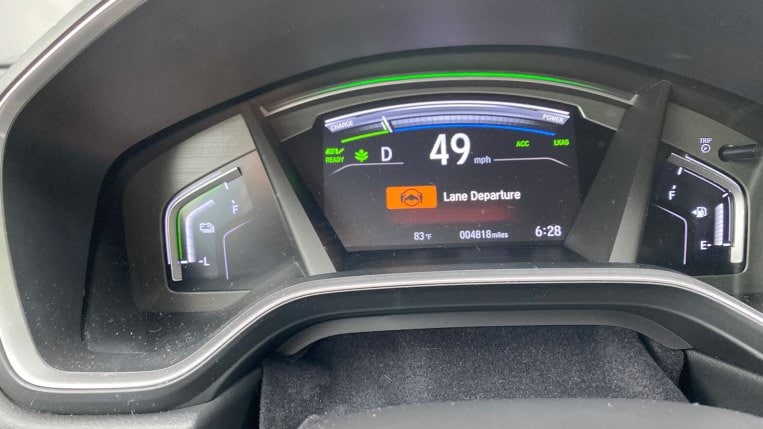
Here is where cutting-edge technologies live. As Velcro and microwave ovens were born from the race to space, most of the driver aids listed here result from the race to develop fully self-driving vehicles.
Indeed, we are decades away from cars without steering wheels and pedals zipping around on accident-free streets. However, we will continue to reap the rewards of the ever-changing safety technology as carmakers work toward that goal.
Some of these driver aids combine to create even more advanced driver assistance systems (ADAS).
Blind-Spot Monitoring (BSM)
BSM takes some of the adventure and danger out of changing lanes.
To keep track of approaching vehicles in neighboring lanes, a basic BSM relies on radar or ultrasonic sensors typically found on both sides of the rear bumper. Some more advanced systems team the sensors with side-mounted cameras.
BSM alerts you to vehicles entering the blind spots in your vehicle’s rear-quarter areas. These alerts can take the form of warning lights on your vehicle’s A-pillars, outboard mirrors, or, if your car is so equipped, the head-up display. The warning may also be tactile if your car has a haptic steering wheel or driver’s seat.
Brake Assist
Brake assist was around before the push for semi-autonomous cars. Nonetheless, it’s still a valuable safety feature.
Drivers are human, so their reactions to emergencies vary. Brake assist is engineered to provide extra braking in emergencies when the driver fails to apply the brakes fully. In such instances, the brake-assist system initiates and then maintains emergency braking until the driver releases the brake pedal.
Some brake-assist systems measure the time it takes a driver to switch from the accelerator to the brake to determine if it should engage. Radar or camera-based systems anticipate emergency braking situations, initiating braking a split second before the driver’s foot reaches the brake pedal.
Sadly, the human factor again comes into play if the driver panics, releasing the brake pedal prematurely.
Forward Collision Warning (FCW)
We are reasonably sure forward collision warning will be one of the current advanced safety technologies mandated by the government. Having already found its way into several mainstream vehicles as standard equipment, it is gaining ground as a must-have driver-assist/safety technology. Moreover, its popular companion technology, automatic emergency braking, is mandated for the 2029 model year.
Employing cameras, radar, lasers, or some combination of the three, FCW detects cars or other objects in front of your vehicle. More sophisticated FCW examples can also pick up pedestrians, cyclists, and even animals.
As an FCW-equipped vehicle closes in on a detected object and senses a potential collision, the system issues a warning. That warning may be visual, audible, tactile, or some combination of the three.
Many of the newer FCW systems also include automatic emergency braking, see below.
Intersection Turn Assistance (ITA)
A function of FCW and automatic emergency braking, this system examines intersections for potential collisions. For example, they could be vehicles, pedestrians, or cyclists crossing your path. It will also alert you to the approach of a vehicle in the opposite direction as you initiate a left-hand turn. It provides both warnings and automatic braking if the driver doesn’t react.
Lane-Centering Assist (LCA)
LCA is a more advanced form of lane-keeping assist. It takes a more active role in keeping your vehicle centered in its lane. It also uses a forward-pointed camera to monitor lane boundaries. Very often, LCA uses some form of Steering Assist to steer around curves.
Note: LCA may only function when the adaptive cruise control is engaged.
Lane-Departure Warning (LDW)
LDW is a reasonably common technology that uses a front-mounted camera to monitor your vehicle in relation to the lane markers (center and side stripes). When it sees the car is veering close to the lane markers on either side, it issues a warning, signaling you to steer back into your lane.
That warning may be visual, audible, tactile, or some combination of the three.
More advanced LDW systems will subtly nudge you back into your lane.
Note: Usually, if you fail to use your turn signal when changing lanes, LDW will issue its warning.
Lane-Keeping Assist (LKA)
LKA is a more sophisticated version of lane-departure warning. Some carmakers marry the two and call the driver aid Lane-Departure Warning with Steering Assist.
Here again, a forward-pointed camera keeps track of your vehicle in relation to the lane-marking stripes. LKA is a bit more intrusive than the nudge of some LDW systems. It uses the steering system to steer the vehicle back into its lane. Some systems use the independent-braking capability of ABS to gently brake the wheel as it is about to cross the line.
Making a lane change without engaging the turn signal will cause LKA to gently steer against your steering wheel input to keep you in the current lane. The force isn’t enough to overpower or even challenge your steering input, but it will grab your attention.
Lane-Tracing Assist (LTA)
LTA also helps drivers stay centered in the appropriate lane by taking lane-centering assistance up a notch or two. However, where lane markers may not be apparent or consistent, LTA will trace the vehicle’s path ahead of it.
Here again, it works in conjunction with the vehicle’s adaptive cruise control.
Pedestrian Detection
Just a more sensitive version of forward-collision warning or rear cross-traffic warning, pedestrian detection can identify a pedestrian in the vehicle’s path. Because pedestrian detection is more sophisticated than FCW, it usually, but not always, includes automatic emergency braking. Many of today’s FCW systems can also detect cyclists and sometimes even animals.
Rear Automatic Emergency Braking (RAEB)
This feature automatically brakes when it senses a collision when in reverse, RAEB may also have a pedestrian-detection function.
Rear Cross-Traffic Alert (RCTW)
More often than not, RCTW is paired with blind-spot monitoring because both rely on radar or ultrasonic sensors embedded on each side of the rear bumper. Sometimes RCTW involves the backup camera, as well.
RCTW activates when reversing your vehicle out of a parking spot, driveway, or otherwise backing into the path of crossing traffic. It alerts you to vehicles approaching from either side on that path. The warning can be audible, visual, or tactile.
Some RCTW systems include automatic full braking, preventing you from backing into trouble.
Semi-Autonomous Driving
Semi-autonomous driving is a blending of many individual advanced driving assistance systems (ADAS). It allows a vehicle to perform many driver tasks with the driver at the wheel. It’s an eyes-on-the-road, hands-on-the-wheel level of autonomous driving.
These systems can accelerate, steer, brake, and even change lanes (in more advanced systems) on their own under particular conditions. When properly equipped, the vehicle can even park itself. The experts identify this as Level 2 autonomy on an autonomy scale ranging from Level 0 (no autonomy) to Level 5 (full autonomy).
Several carmakers, such as General Motors with its Super Cruise, have perfected their ADAS to allow hands-free operation on specific designated highways.
Speed Control Safety Features
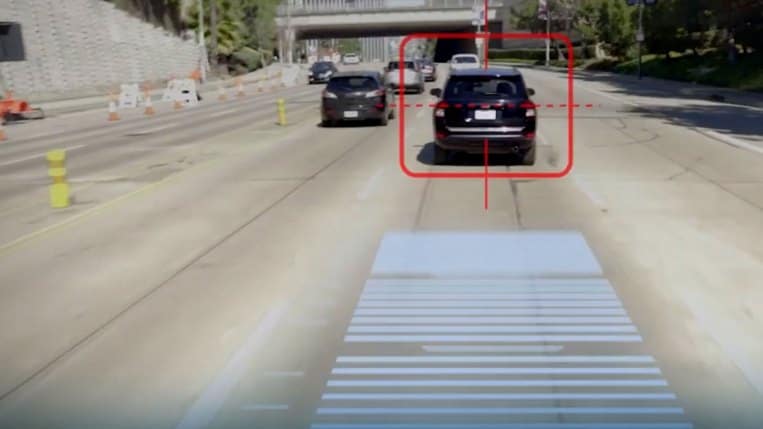
A key component of self-driving cars is the capability of a vehicle to maintain its position while traffic around the car safely accelerates, slows, and stops.
Adaptive Cruise Control (ACC)
Adaptive cruise control is to regular cruise control what your smartphone is to two tin cans and a string.
Standard cruise control is designed to maintain a preset speed, regardless of the behavior of the surrounding traffic. The driver can apply the brake to disengage it or push the “Resume” button to re-engage it. Adjusting the speed setting to reflect changing speed limits also falls to the driver.
However, adaptive cruise control can think for itself and, in certain situations, act on its own. Once engaged by the driver, adaptive cruise control uses cameras, radar, and lasers to monitor the surrounding traffic. Yes, the driver must still physically engage the system, but most adaptive cruise control systems can pretty much take it from there.
Some ACC systems reduce speed to match that of the vehicle ahead of them and come to a complete stop, if necessary, to maintain a safe distance. The driver may have to tap the accelerator with less advanced systems to put the vehicle back in motion. However, other systems will resume on their own.
More sophisticated ACC systems can tie into the vehicle’s GPS mapping. Consequently, they are aware of upcoming curves and can even automatically slow the car accordingly. Moreover, you can program some ACC systems to recognize new speed zones and adjust the vehicle’s speed accordingly.
To whatever extent the technology of a particular adaptive cruise control system is advanced, it adapts to its surrounding traffic.
Most of today’s crop of more sophisticated steering driver aids require adaptive cruise control engagement to function.
Automatic Emergency Braking (AEB)
Often paired with forward collision warning, automatic emergency braking relies on cameras, radar, sensors, or a combination of the three to identify objects in the vehicle’s path. If the system determines the potential for a collision, that awareness turns into action.
The action depends on the AEB system. Some systems will apply the brakes, bringing the vehicle to a complete stop if necessary. Other systems will only slow the car until the driver activates the brake, which lessens the impact if the driver doesn’t react. As mentioned, this will be federally mandated to be included in every vehicle starting in 2029.
Traffic Sign Recognition (TSR)
As a driver aid, TSR is functional but passive. It simply uses a forward-pointed camera to identify road signs. Its program includes a catalog of road signs deemed worthy of a driver’s attention. These include signs for the speed limit, stop, slow, and yield. Also prioritized are warning signs, such as pedestrian crossing, school zone, rail-road crossing, curve ahead, and so forth.
The forward-pointed camera captures an image of upcoming road signs, processes them, identifies those deemed important, and projects those images on the touchscreen, head-up display, or some other designated screen.
TSR is useful because it acts as a backup for the driver who might otherwise miss a critical sign.
Vision and Headlight Safety Features
Advancements to driving at night have gone beyond LED and projector-beam headlight technologies.
Automatic High Beams
Also called high-beam assist, this technology relies on a forward-pointing camera or photosensor to identify the headlights of approaching vehicles. It is also programmed to react to taillights that become visible as you close the distance on cars in front of you.
A driver must initially turn the system on, though automatic high beams will be the default setting. The high beams remain engaged unless the system detects headlights or taillights in front of you at a set distance. The system will then disengage the high beams. When no headlights or taillights are detected, the high beams will reengage.
A system disengaging and engaging the high beams means one less thing for the driver to do manually.
Adaptive Headlights
For the most part, traditional headlights are fixed. That is to say, pointed straight ahead. Some vehicles do have a self-leveling feature to compensate for heavy loads weighing down the rear end. However, they still point straight ahead.
Adaptive headlights, however, are capable of swiveling to some degree based on the direction the steering wheel is turning when cornering. Consequently, these headlights can illuminate the area to your right or left as you turn.
Night Vision
Lighting up the night can involve more than just headlights. Night vision is gaining popularity in cars. There are two types: passive and active.
Passive systems use a thermographic camera capable of seeing heat. They can see and display the heat coming off a person, animal, or any object that’s putting off more heat than the air around it. The camera translates what it sees into a black-and-white image on a monitor.
An active system uses infrared light sources that illuminate the road ahead. Because infrared is outside a human’s visible spectrum, it doesn’t affect oncoming drivers. A special infrared camera gathers the data, displaying images on a monitor.
A passive system has trouble seeing inanimate objects that don’t emit heat. Active systems can fail when infrared light is blocked by fog, snow, and rainy conditions.
Other Advanced Car Safety Features
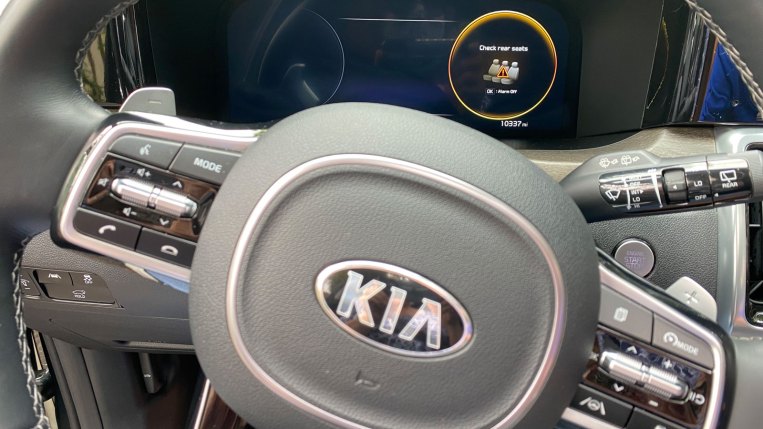
Although safety finally has a seat at the table alongside styling, fuel economy, performance, and convenience as a reason people buy cars, safety isn’t new. Advances in safety have been made over the years. Here we include safety features better categorized as common rather than standard.
Active Head Restraints
Although front-seat head restraints have been mandatory in passenger cars since 1969, active head restraints are not. Not every head restraint is an active head restraint. Saab pioneered the widespread use of active head restraints in 1998, with Volvo close behind.
Different methods can achieve the action of an active head restraint, but essentially, it moves the head restraint up and forward during a rear-end collision. Consequently, it prevents the head from snapping back or whiplashing.
Driver-Attention Monitor
Using a sensor-equipped camera with LED detectors, a driver-attention monitor or drowsiness detection system tracks a driver’s alertness through eye movements, head position, eyelid activity, and so forth. Some more sophisticated versions tie other advanced driver aids into the monitoring to track steering behavior and more.
When the system determines a driver’s alertness is waning, it issues visual or audio warnings.
Head-Up Display (HUD)
Designed to reduce the time a driver’s eyes leave the road to check vehicle speed or other vital information, a head-up display enables you to keep your eyes forward on the road ahead. A projector on the dashboard at the windshield base displays critical driver information on the windshield just below the driver’s line of sight.
Some HUD systems allow a driver to pick and choose the information displayed. This information can include turn-signal repeaters, vehicle speed, next-turn navigation instructions, and so forth. Studies show that using a head-up display can lead to faster reaction times in certain instances and improve driving performance.
Parking Assist Systems
Parking assist systems utilize a grab-bag of automated systems designed to eliminate at least some of the guesswork and stress out of parking your car.
These systems offer different levels of automation. Once a space is found, some systems will steer the vehicle into the parking space while the driver operates the pedals. Others will find the spot and then fully park the car. Others will allow the driver to pull up to a diagonal parking spot, step out, and then use the key fob to pull the vehicle into the parking spot.
Other systems allow the driver to summon a parked car to their location.
Rain-Sensing Wipers
When the rain-sensing wiper system senses moisture on the windshield, it automatically engages the wipers. The driver doesn’t need to readjust the wiper speed as the rain volume changes because the system automatically adjusts.
Safe Exit
Common in Hyundai models, as well as other makes, Safe Exit uses its rear-mounted sensors to detect vehicles in a neighboring lane approaching from the rear. The system sounds a warning and prevents the doors on that side of the car from opening. Once the danger has passed, the doors will function.
Telematics
When you hear the word Telematics, think of the telephone — it’s your car’s way of making emergency calls to outside providers and, like a smartphone, provides many convenience features that improve your life.
Telematics is the marriage of communications and computer data. In vehicles, it involves GPS tracking, cell-phone service, and a vehicle’s computer system. It allows a direct connection between your smartphone, car, and telematics provider.
Telematics can automatically summon first responders in the event of a crash, remotely unlock your car, locate your vehicle, provide a weather report, or provide turn-by-turn directions. In its more sophisticated forms, telematics usually requires a subscription as a convenience feature or as a safety-security feature.
